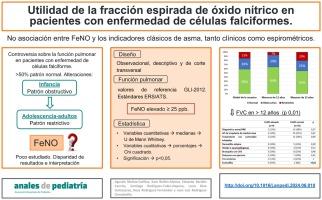镰状细胞病患者呼出一氧化氮分数的实用性
IF 1.5
4区 医学
Q2 PEDIATRICS
引用次数: 0
摘要
导言镰状细胞病患者在肺功能测试中表现出不同的模式。方法 我们在 2021 年 11 月至 2023 年 1 月期间进行了一项横断面、观察性和描述性研究,研究对象包括能够进行一氧化氮测试的 6 至 18 岁镰状细胞病患者。我们采用了 GLI-2012 参考值和 ERS/ATS 标准。结果样本包括 43 名患者,中位年龄为 12 岁(IQR,10-15 岁)。我们没有发现 FeNO 明显升高(≥ 25 ppb)与哮喘诊断(P = .37)、肺活量测定的阻塞模式(P = .67)、支气管扩张剂试验阳性(P = .53)、感冒或类似流感症状的临床支气管高反应性(P = .结论我们发现镰状细胞病患者的 FeNO 值与哮喘的典型特征(临床或肺活量)之间没有关联。因此,这些患者的气道炎症机制可能有所不同。本文章由计算机程序翻译,如有差异,请以英文原文为准。

Utilidad de la fracción espirada de óxido nítrico en pacientes con enfermedad de células falciformes
Introduction
Patients with sickle cell disease exhibit different patterns in pulmonary function tests. In particular, there is little evidence on the fractional exhaled nitric oxide (FeNO) test, and its value ranges and its interpretation in these patients have been under debate in recent years.
Methods
We conduced a cross-sectional, observational and descriptive study between November 2021 and January 2023 including patients aged 6 to 18 years with sickle cell disease able to perform the FeNO test. We applied the GLI-2012 reference values and the ERS/ATS standards. We defined statistical significance as P < .05.
Results
The sample included 43 patients with a median age of 12 years (IQR, 10-15). We did not find an association between significantly elevated FeNO (≥ 25 ppb) and the diagnosis of asthma (P = .37), an obstructive pattern in spirometry (P = .67), a positive bronchodilator test (P = .53), clinical bronchial hyperreactivity in the context of cold or flu-like symptoms (P = .48), cough with exercise (P = .42) or nocturnal cough (P = 1.0), but found an association with peripheral eosinophilia (P < .01).
Conclusions
We found no association between FeNO values and the classic features of asthma (clinical or spirometric) in patients with sickle cell disease. Therefore, airway inflammation mechanisms are probably different in these patients.
求助全文
通过发布文献求助,成功后即可免费获取论文全文。
去求助
来源期刊

Anales de pediatria
医学-小儿科
CiteScore
2.10
自引率
4.80%
发文量
155
审稿时长
44 days
期刊介绍:
La Asociación Española de Pediatría tiene como uno de sus objetivos principales la difusión de información científica rigurosa y actualizada sobre las distintas áreas de la pediatría. Anales de Pediatría es el Órgano de Expresión Científica de la Asociación y constituye el vehículo a través del cual se comunican los asociados. Publica trabajos originales sobre investigación clínica en pediatría procedentes de España y países latinoamericanos, así como artículos de revisión elaborados por los mejores profesionales de cada especialidad, las comunicaciones del congreso anual y los libros de actas de la Asociación, y guías de actuación elaboradas por las diferentes Sociedades/Secciones Especializadas integradas en la Asociación Española de Pediatría.
 求助内容:
求助内容: 应助结果提醒方式:
应助结果提醒方式:


